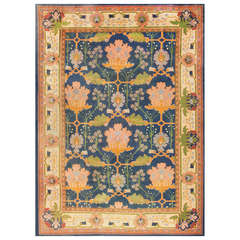Gavin Morton On Sale
Recent Sales
Early 20th Century Irish Arts and Crafts Western European Rugs
Wool
A Close Look at arts-and-crafts Furniture
Emerging in reaction to industrialization and mass production, the Arts and Crafts movement celebrated handcrafted design as a part of daily life. The history of Arts and Crafts furniture has roots in 1860s England with an emphasis on natural motifs and simple flourishes like mosaics and carvings. This work is characterized by plain construction that showcases the hand of the artisan.
The earliest American Arts and Crafts furniture dates back to the start of the 20th century. Designers working in this style in the United States initially looked to ideas put forth by The Craftsman, a magazine published by Wisconsin native Gustav Stickley, a furniture maker and founder of the Craftsman style. Stickley’s furniture was practical and largely free of ornament. His Craftsman style drew on French Art Nouveau as well as the work he encountered on his travels in England. There, the leading designers of the Arts and Crafts movement included William Morris, who revived historical techniques such as embroidery and printed fabrics in his furnishings, and Charles Voysey, whose minimal approach was in contrast to the ornamentation favored in the Victorian era.
American Arts and Crafts work would come to involve a range of influences unified by an elevation of traditional craftsmanship. The furniture was often built from sturdy woods like oak and mahogany while featuring details such as inlaid metal, tooled leather and ceramic tiles. The style in the United States was led by Stickley, whose clean-lined chairs and benches showcased the grain of the wood, and furniture maker Charles Rohlfs, who was informed by international influences like East Asian and French Art Nouveau design.
Hubs in America included several utopian communities such as Rose Valley in Pennsylvania and the Byrdcliffe Arts and Crafts Colony in New York, where craftspeople made furniture that prioritized function over any decoration. Their work would influence designers and architects including Frank Lloyd Wright, who built some of the most elegant and iconic structures in the United States and likewise embraced a thoughtful use of materials in his furniture.
Find antique Arts and Crafts chairs, tables, cabinets and other authentic period furniture on 1stDibs.
Finding the Right area-rugs-carpets for You
Antique, new and vintage area rugs and carpets are a simple way to add warmth and style to any space. Area rugs can be seasonal or changed with other decorative objects to refresh an interior. Carpet piles materials can vary from wool and cotton to silk and synthetic fibers, and the purpose of a floor covering can range from reducing noise to offering a place to sit.
Vintage rugs can ground a space, and arranging furniture around them creates a measured focal point. Key furniture pieces can be placed on the rug or just the legs, such as with furniture like coffee tables in your living room.
So, how can you tell if a rug is high quality or vintage?
The three main components that determine the quality of a piece are the dyes, the wool and the number of knots per square inch. Ultimately, however, if you want to be sure the rug you’re buying is truly an antique, it is best to consult an expert.
If you want a creative design that stands out, area rugs or carpets can provide layers of color. Rugs and carpets reflect a global heritage of textiles and weaving, such as ornately patterned Persian and Indian designs. Visually striking Chinese rugs can add a delicate touch of color, while modern rugs make a statement with their geometric patterns.
Turkish rugs, with their ruby reds and misted blues, their entwined botanical designs and rhythmic geometries, are as beloved today as they were in the 13th century. The West’s current infatuation with Moroccan and North African tribal rugs stretches to the mid-20th century, when modern furniture designers embraced bold geometric patterns and even bolder palettes as counterpoints to form-follows-function interiors. Alvar Aalto, Frank Lloyd Wright and Le Corbusier were among the designers who used these rustic, natural rugs to offset austere interiors.
If you properly maintain your antique and vintage rugs, they will last for many years. When you’re thinking about how to clean a rug, it is important to keep in mind that your vacuum is not too harsh for your favorite floor covering. Frequent vacuuming is in fact necessary to remove everyday dirt that otherwise wears down the pile. Omri Schwartz of Nazmiyal does, however, stipulate that “it’s best to use an ordinary suction vacuum without bristles, as the bristles can damage the rug’s pile.” Rotating the carpet every couple of years is also recommended — it ensures that the rug gets even foot traffic.
On 1stDibs, find a vintage rug or carpet to add a layer of beauty and function to your room.
